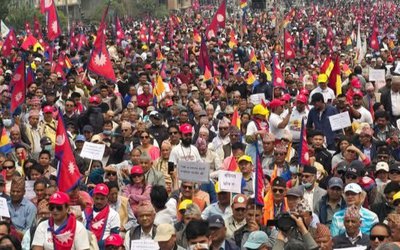The Nepali Finance Minister in his Budget Speech of 2077/78 has taken the Nepali population for a ride! Why is he looking at his countrymen with myopic eyes? The promised utopia of energy generated by our rivers and the promised benefits have once again become a mirage. He has in fact dashed the hopes of the Nepali population by throwing it against the hard rock of monetary conjectures.
Following the downfall of the Rana oligarchy, Nepal wished to open its doors by land and air to the outside world as the rights of landlocked countries was not in vogue then! Gaucher Airport, later renamed Tribhuvan International Airport, came into being and the Indian Army which had taken up positions in various parts of Nepal started the construction of the Tribhuvan Raj Path by going round and round the mountains between Kathmandu and Hetauda to reach Madesh. The shortest route via the banks of the Bagmati which Christian missionaries had used when Prithivi Narayan Shah drove them out from the Kathmandu Valley was not considered. It is said that the travel time by a sturdy jeep or Landrover was barely two hours then. Some years later the Kanti Raj Path was announced but for some unknown reason not much investment was done on this road though it would have reduced Nepal’s fuel requirements drastically.
At that time a small rope-way, constructed by the efforts of a British engineer named Kilburn to bring essential goods and luxury items from Calcutta for the Rana rulers was in use. As the haulage was small this was replaced by a much bigger installation by the Riblett Tramway Company of USA. This increased the capacity greatly. But these developments and visions were not to last long. The truck movements along the new road increased by leap and bounds as the material demands of the Nepali populace increased. Competition became fiercer and the truck carting lobby saw to it that the ropeway was not able to compete and soon disappeared. Was this due to the ‘Petrol Lobby’ that this came about? The supplies of the diesel-petrol-kerosene-gas, the carriers, the pump stations and the retailers all had their fingers in the ‘Fuel Pie’!
A flash in the Nepali sky was about two decades back when the Chinese aided trolley bus provided mass transport service between Bhaktapur and Kathmandu. Safa Tempos cruised the city streets and the atmosphere of the capital was liveable. It was a time when the government encouraged use of Nepal generated electricity. Alas it was not to last long.
It was over twenty years ago that thought was given to have a pipeline to bring fuel to Nepal to lessen environmental pollution. This has been done but with changed circumstances a second pipeline as envisaged then is not required in our changed circumstances.
The bare truth is that most of the hard-earned foreign currency earned by Nepali labour abroad was used to pay for the import of fuel and luxury items of the residents of the capital and other town dwellers of Nepal. It is their vehicles that are causing pollution which causes respiratory diseases and even more likelihood to Covid-19 infection. The lockdown has shown that the environmental conditions in urban centres improves and makes it better for living. To maintain this state in future, it is electrical vehicles (EVs) which must be used. At the last election, Nepal Communist Party’s manifesto had pledged to have EVs only on the Kathmandu streets within three years!
The load-shedding which reached as much as sixteen hours in a day and the winter blackouts had plagued the Nepali population for many years. Many factories could only function at a fraction of their capacity and were dependent on acquiring fuel at exorbitant prices. Children’s studies were at a standstill and they were in tremendous difficulties whilst preparing for their terminal examinations. Even the high-ups of the Oil Nigam and the Energy Ministry were rumoured to be involved in a scam conducted by importers and sellers of invertors and generators over a course of years on the unsuspecting public. It was only about two years ago as a result of a stand by Kulman Ghising that this fiasco/ subterfuge was stopped.
There is now a worldwide trend that the energy sources of the future should be the wind plus water of the river and waves of the seas. This is what has been done in many countries of the world. We in Nepal have been boasting over the years about our great hydropower potential but it is only now that we are in a position to give some facilities to the people of this country. Now a second opportunity has come our way to make this into a reality. In fact, we had been told that the authorities were making plans and had even sent proposals to the ministry so that rates for household consumption would be reduced. This was to encourage the populace to use electricity for domestic purposes – cooking meals, lighting homes and keeping cool or warm in summer and winter respectively.
It was announced that the Nepal Electricity Authority had even proposed for drastic reduction of rates so that the people would thus use the energy produced by our own rivers for both domestic and industrial use. The proposal to give free electricity to all using less than 10 units, by the Minister of Energy is to be appreciated as a form of social justice. Whilst some benefit has been given to industries, the domestic user has been ignored or forgotten. Why the increased tax on induction cookers if household appliances are to be encouraged? Is there a lobby that does not want our dependency of energy import to be decreased? Has our Finance Minister been subjugated to pressure from some invisible quarter? Is this year’s budget proof that we have been hood-winked?
The almost likely 82 days of lockdown has brought about in the urban centres of Nepal, a great change in environmental conditions. Cities in Nepal will benefit greatly by use of electric vehicles. Was the EV for our President just a publicity stunt? Great expectations were generated stating that electric Mo-peds, cars and even buses will roll along our urban streets to make them even more environment friendly. Custom duty on EVs has now been increased from 30% to 80% and excise duty from 5% to 80%. This will increase cost of EVs from 30% to 150%! This action of the Finance minister by taxing EVs so much is against the national interest of Nepal and certainly not rational.
The author writes fiction under the name of Mani Dixit. Website: www.hdixit.org.np. Twitter: @manidixithd

Hemang Dixit
The author writes fiction under the name of Mani Dixit. Website: www.hdixit.org.np. Twitter: @manidixithd
- Top Heavy
- Sep 20, 2023
- Most Able?
- Sep 04, 2023
- Changing Times
- Aug 21, 2023
- Nepali Shenanigans
- Aug 03, 2023
- Budget Naataks
- Jun 29, 2023














